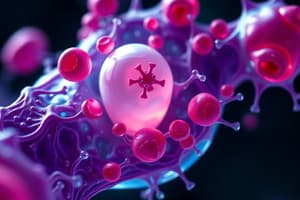Podcast
Questions and Answers
Which organelle is responsible for synthesizing phospholipids of the nerve system?
Which organelle is responsible for synthesizing phospholipids of the nerve system?
- Lysosomes
- Mitochondria
- Peroxisomes (correct)
- Golgi Complex
Which organelle is responsible for detoxifying toxic compounds like ethanol in liver and kidney cells?
Which organelle is responsible for detoxifying toxic compounds like ethanol in liver and kidney cells?
- Mitochondria
- Lysosomes
- Golgi Complex
- Peroxisomes (correct)
What is the function of catalase in peroxisomes?
What is the function of catalase in peroxisomes?
- To degrade lipids
- To synthesize phospholipids
- To produce hydrogen peroxide
- To split peroxide into water and oxygen (correct)
Which organelle is responsible for the degradation of alcohol in yeast growing in an alcohol-rich medium?
Which organelle is responsible for the degradation of alcohol in yeast growing in an alcohol-rich medium?
What is the function of glyoxysomes in plant germinating seeds?
What is the function of glyoxysomes in plant germinating seeds?
What is the consequence of mutations causing abnormal peroxisome synthesis?
What is the consequence of mutations causing abnormal peroxisome synthesis?
Which organelle is responsible for pushing the cell wall, establishing a hydrostatic pressure called turgor pressure?
Which organelle is responsible for pushing the cell wall, establishing a hydrostatic pressure called turgor pressure?
What is the function of contractile vacuoles in protozoa?
What is the function of contractile vacuoles in protozoa?
In which organelle does the synthesis of most of the lipids of a cell's membranes occur?
In which organelle does the synthesis of most of the lipids of a cell's membranes occur?
What is the primary function of the liver in terms of detoxification?
What is the primary function of the liver in terms of detoxification?
Which of the following is a function of the rough Endoplasmic Reticulum?
Which of the following is a function of the rough Endoplasmic Reticulum?
What is the cis face of the Golgi complex?
What is the cis face of the Golgi complex?
What is the primary function of lysosomes in animal cells?
What is the primary function of lysosomes in animal cells?
What is the role of the Golgi complex in plant cells?
What is the role of the Golgi complex in plant cells?
Which of the following is a hypothesis for Golgi complex function?
Which of the following is a hypothesis for Golgi complex function?
What is the result of alcohol abuse on the liver?
What is the result of alcohol abuse on the liver?
Which organelle is responsible for synthesizing hydrolytic enzymes that are routed to lysosomes?
Which organelle is responsible for synthesizing hydrolytic enzymes that are routed to lysosomes?
What is the primary function of lysosomes in animal cells?
What is the primary function of lysosomes in animal cells?
What is the role of sugar motifs on lysosomal enzymes in the Golgi apparatus?
What is the role of sugar motifs on lysosomal enzymes in the Golgi apparatus?
What is the term for the process by which a cell engulfs and breaks down foreign substances or cellular waste?
What is the term for the process by which a cell engulfs and breaks down foreign substances or cellular waste?
What is the name of the organelle responsible for receiving and processing vesicles from the Golgi apparatus?
What is the name of the organelle responsible for receiving and processing vesicles from the Golgi apparatus?
What is the result of a lysosomal storage disease, such as Tay-Sachs disease?
What is the result of a lysosomal storage disease, such as Tay-Sachs disease?
What is the primary function of vacuoles in plant cells?
What is the primary function of vacuoles in plant cells?
What is the term for the membrane that surrounds the vacuole?
What is the term for the membrane that surrounds the vacuole?
Study Notes
Cell Organelles
- Vacuoles play a role in homeostasis, conserving pH by taking in hydrogen ions, and establish a hydrostatic pressure called "turgor pressure", providing mechanical strength to the cell.
- Vacuoles are present in many types of animal cells and in unicellular protists like protozoa.
- Most protozoa have food vacuoles that fuse with lysosomes to digest food, and contractile vacuoles to remove excess water from the cell.
Peroxisomes
- Peroxisomes are simple, membrane-bound, multi-functional organelles of the cytoplasm that carry out diverse metabolic reactions, including substrate oxidation leading to the formation of hydrogen peroxide.
- Peroxisomes are involved in the oxidation of very-long-chain fatty acids, the oxidation of uric acid, and the synthesis of plasmalogens.
- Plant glyoxysomes, which carry out the glyoxylate cycle, are a type of peroxisome.
- Peroxisomes produce hydrogen peroxide during oxidation reactions, which is then broken down by catalase into harmless water and oxygen.
- Peroxisomes are found in cells synthesizing, storing, and degrading lipids, and also synthesize phospholipids of the nerve system.
- Mutations causing abnormal peroxisome synthesis are likely to cause mental retardation.
Mitochondria and Chloroplasts
- Energy is in the form of light or molecules (glucose).
Lysosomes
- Lysosomes are small sacs of digestive enzymes dispersed in the cytoplasm of most animal cells.
- They contain about 40 enzymes and have a pH of around 5.
- Lysosomes degrade complex molecules from bacteria and debris ingested by scavenger cells (phagocytes).
- Primary lysosomes are formed by budding from the Golgi, and their hydrolytic enzymes are synthesized in the RER.
- Secondary lysosomes are formed by the fusion of primary lysosomes with vesicles containing ingested materials.
- Lysosomal storage diseases occur when one of the digestive enzymes is absent, leading to the accumulation of undigested materials in cells.
Vacuoles (continued)
- Vacuoles are larger than vesicles and can occupy up to 90% of the cell volume in plant cells.
- They store salts, pigments, food, metabolic waste, inorganic compounds, and sometimes proteins.
- Vacuoles contain a lot of dissolved materials, which is why they take in water.
- They can be minor or extended in amounts, such as in liver cells, where they serve in synthesizing and processing cholesterol and detoxifying carcinogens and drugs.
Rough ER
- The rough ER is composed of a network of flattened sacs (cisternae) with ribosomes bound to its cytosolic surface.
- The functions of the rough ER include the synthesis of proteins and most of the lipids of a cell's membranes.
- The addition of sugars to the asparagine residues of proteins begins in the rough ER and continues in the Golgi complex.
Golgi Complex
- The Golgi complex consists of flattened sacs called cisternae, with a lumen in each sac.
- The cis face (entry surface) receives vesicles from the ER, while the trans face (exit surface) packages molecules in vesicles and transports them out of the Golgi.
- The Golgi complex is developed in cells producing a lot of glycoproteins, and in animal cells, it manufactures lysosomes.
- Two hypotheses for Golgi function are the vesicular transport model and the cisternal maturation model.
Studying That Suits You
Use AI to generate personalized quizzes and flashcards to suit your learning preferences.
Description
Learn about the functions of vacuoles and peroxisomes in maintaining cellular homeostasis, including pH regulation, mechanical strength, and cellular processes.




